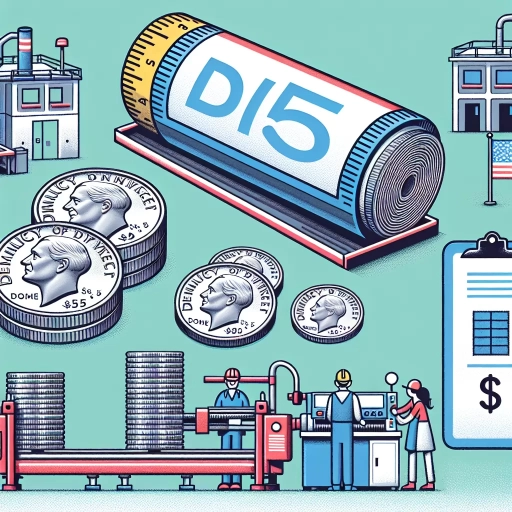How Much Is A Roll Of Dimes
Follow Currency Mart August 4, 2024
Where to purchase Foreign Currencies?

Understanding The Basics Of Dime Rolls
The Composition of a Dime Roll
A roll of dimes is a specific quantity of dimes that is accessible at banks and other financial institutions. It contains exactly 50 dimes, each of which is composed of 91.67% copper and 8.33% nickel. The dimes are distributed in a plastic or paper wrapper, and the roll's total value is $5.00. While these rolls can be kept intact for collection purposes or used for ease of storage and transport, this value does not change even when individual dimes are removed from the roll. Understanding this basic makeup of dime rolls is essential as a starting point in understanding its broader value and implications.The Standard Weight of a Dime Roll
A dime's weight is approximately 2.268 grams which, when multiplied by the 50 dimes in a roll, results in a total weight of approximately 113.4 grams or 4 ounces for a roll of dimes. Understanding this weight is important in verifying the completeness and authenticity of a dime roll. Because coins can sometimes be subject to wear or corrosion, or there can be mistakes or deception in the coin roll wrapping process, a roll that is significantly under this standard weight may indicate a problem such as missing or counterfeit dimes.Historical Dime Roll Prices
The monetary value of a dime roll has remained consistent at $5.00 due to its consistent composition and the fixed value of the dime as a unit of US currency. However, the market value of dime rolls has fluctuated over time due to various economic factors. For instance, during periods of high inflation, the intrinsic value of the metals comprising dimes may increase, potentially making dime rolls a profitable investment. Furthermore, certain types of dimes - such as older or rare dimes - can increase the value of a roll due to their collectible value.Factors That Influence the Value of Dime Rolls
Intrinsic Metal Value and Global Market Prices
As previously alluded to, the value of the metals that make up dimes can factor into their overall value. In times when the value of copper and nickel increases, the intrinsic value - that is, the worth of the dime's physical materials - also increases. This is influenced by global metal markets and can fluctuate based on a myriad of factors such as global economic stability, metal scarcity, and production costs. This explains why some investors buy rolls of dimes during certain periods and hold onto them in anticipation of possible increases in metal prices.Collectible and Numismatic Value
Beyond the physical materials, certain dimes can carry significant collectible value. This usually applies to older, rarer, or mint-condition dimes that are sought after by coin collectors. Dime rolls that contain these types of dimes can carry a value far beyond the $5.00 face value of the roll. Factors that can contribute to this numismatic value include the age of the dimes, their condition, their mintage (the location and year they were produced), and the overall demand among coin collectors.Condition and Completeness of the Dime Roll
As with any collectible item, a dime roll's condition plays a role in its overall value. A roll that is in excellent physical condition, with an intact wrapper and dimes that are free of excessive wear, corrosion, or other damage, will generally be more valuable than one that is not. Furthermore, the roll's completeness (whether it contains the full 50 dimes) also factors into its value; an incomplete roll, or one that contains counterfeit or foreign coins, will be worth less than one that is complete and genuine.Ways to Use and Collect Dime Rolls
Purchasing and Saving Dime Rolls as an Investment
One of the ways people use dime rolls is as a form of investment. Particularly in uncertain economic times, some individuals turn to physical assets like coins as a way to protect their wealth. The hope is that the intrinsic value of the metals within the dimes, or the potential numismatic value of rare or old dimes within the roll, will increase over time, providing a return on the initial investment. This was particularly common during periods of high inflation of the US dollar in the past, with individuals buying up dime rolls as a hedge.Collecting Dime Rolls for Numismatic Interest
Another common use of dime rolls is for numismatic (coin collecting) purposes. Many coin collectors enjoy the process of acquiring and sorting through dime rolls to look for valuable or interesting finds. These could include old dimes, dimes from particular mintages, or even error coins that holds special value in the numismatic world. For these individuals, the value of a dime roll goes beyond its monetary or metal worth; rather, the value lies in the joy of the hunt and the potential for rare discoveries.Using Dime Rolls for Practical Purposes
Finally, dime rolls can be used for practical purposes. In cash-based businesses or in other situations where large amounts of change are handled, having coins in roll form can be much more efficient than dealing with loose change. Dime rolls are compact, easy to store, and allow for quick, standardized transactions. Additionally, they can be easily obtained from banks or other financial institutions, making them a go-to solution for many cash handling needs.
Where to purchase Foreign Currencies?